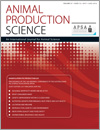
Animal Production Science
Volume 57 Number 12 2017
Manipulating Pig Production XVI
AN17260Seasonal infertility in pigs: what have we achieved and where are we up to?
Seasonal infertility is a very complex syndrome and is characterised by a regular seasonal drop in farrowing rate in Australian pig herds. Over the past 40 years, considerable research investment by industry has identified not only the likely physiological mechanisms involved in seasonal infertility, but also more importantly, nutritional, housing and management interventions that may assist in ameliorating the adverse effects of seasonal infertility. The commercial pork producer now has the tools to identify and implement different strategies to minimise the impact of seasonal infertility on their farms.
AN17362Consumers want pork with ‘adjectives'
A trip to the supermarket shows that most pork products will have a range of adjectives, or credence attributes, on the product labels. The retailers use these credence attributes, such as sow stall-free, to differentiate their product over branded pork, or against their retail competition. This trend will continue with consumers wanting more adjectives with their pork, but will be unwilling to pay significant premiums for these adjectives.
AN17299Innovation in an expanding market: Australian pork is not a commodity
The Australian pork industry, like all Australian agriculture, has much to gain by entering the growing Asian export market. However, due to the relatively small size of the industry on an international level, novel approaches will be used to gain a place in such a crowded and competitive environment. Identification of appropriate consumer networks within target markets is required for the most effective product design and marketing strategies, to sell premium Australian products and not bulk Australian pork as a commodity.
AN17361What are they thinking? Consumer attitudes to meat production in Australia
Meat production has come under increasing scrutiny from consumers and citizens who feel that certain practices are unethical and negatively affect farm-animal welfare. The present paper reviews research that examines consumer attitudes to animal welfare and highlights tensions between consumer and citizen attitudes and behaviours. It concludes with recommended strategies to improve industry–community communication about farm-animal welfare in meat-production industries.
AN17321What does the ‘closed herd’ really mean for Australian breeding companies and their customers?
The perception that the genetic background of the Australian pig population is limiting for genetic improvement of commercial pigs in Australia is considered in the context of well established theory combined with practical evidence. There was no substantive evidence that response to selection in commercial Australian populations was limited. In contrast, there was good evidence for genetic variation in a range of traits, and estimates of effective population sizes are adequate. The authors suggest that, when combined with appropriate selection strategies and mating designs, sufficient genetic resources are present in Australian herds to continue genetic progress within existing Australian populations.
Genomic prediction uses marker genotypes distributed throughout the genome to track the inheritance of chromosome fragments. That information is used to predict the merit of young selection candidates more reliably than can be achieved from prediction using only pedigree and performance information. When innovatively implemented, it can improve the rate and nature of pig improvement and enhance its cost–benefit ratio.
AN17317Genetic improvement and dissemination for the global commercial swine industry
Commercial swine production has become increasingly globalised. The utilisation of continually improving genetic populations can be one input that helps maintain, or increase, the competitiveness of an individual producer or regional industry. So as to deliver these improving genetic populations, genetic providers of today must focus on developing and implementing best science that delivers gain on traits of significant impact on commercial profitability. Providers must also efficiently multiply and disseminate the improved merit to the commercial level.
The pork industry is striving to continuously improve the welfare of pigs and this requires the ability to rigorously assess their welfare throughout the value chain. This paper reviews emerging technologies that offer promise to achieve this. It is clear that there is now the opportunity to develop practical methods to assess the welfare of pigs.
AN17272Novel marine polysaccharides and maternal nutrition to stimulate gut health and performance in post-weaned pigs
Traditional practices have focused on supplementing the piglet diet in the post-weaning period with antibiotic growth promoters to alleviate post-weaning complications. However, the over use of antibiotics are closely related to the growing number of antimicrobial-resistant agents and this raises important concerns about animal and also human health. This review discusses how the supplementation of novel bioactives from marine sources to both the maternal and post-weaning diets alleviates the negative effects associated with weaning.
AN17266Guaranteeing consistently high quality Australian pork: are we any closer?
The delivery of consistently high quality Australian pork and pork products to consumers is essential to supporting future industry growth through increased consumer demand. The present review details recent developments to inform a cuts-based eating quality system for the Australian pork industry, using a pathways approach, to reduce the eating quality fail rate of different pork cuts to less than 10%.
AN17358Current and future antimicrobial resistance issues for the Australian pig industry
Antimicrobial resistance (AMR) is a major global health issue and a significant challenge to Australian pig production. This paper reviews current literature to identify the main AMR issues facing the industry and identifies coordinated control measures. While the Australian industry is in a favourable global position with respect to AMR, further reductions in antibiotic use are required to enhance public health status and remain internationally competitive.



